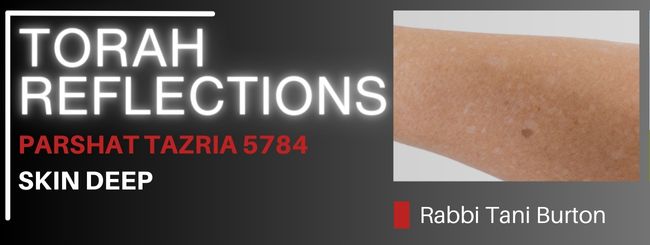בס”ד
Introduction
Leviticus 13:3 describes tzara’at, a spiritual affliction revealing flaws deeper than skin, challenging us to see beyond surface appearances.
Integrating Torah into one’s life through reflection and conversation can be an incredibly fun and engaging experience. It’s a journey of discovery, where ancient wisdom and timeless teachings come to life in our daily experiences. Through reflection, we have the opportunity to dive deep into the rich tapestry of Torah, extracting profound insights and lessons that resonate with our modern lives. The joy lies in the ‘aha’ moments, those instances when a Torah verse or story suddenly connects with our personal challenges, aspirations, and values. And when we engage in conversations about Torah with others, it becomes an interactive exploration, where diverse perspectives and interpretations enhance our understanding. These dialogues often spark excitement and intellectual curiosity, making the learning process both enjoyable and fulfilling. Torah becomes a vibrant and dynamic part of our lives, offering not just guidance but also a source of endless fascination, connection, and growth.
NOTE: Don’t feel obligated to go through every source or answer all the questions—unless you want to. Even one source, or one question will give you plenty of material for discussion and meditation. Enjoy this!
Some thoughts from the parsha
In Leviticus 13:3, it is described that a priest examines a skin condition called tzara’at and sometimes translated as “leprosy”. Unlike the physical phenomenon of leprosy, tzara’at was a spiritual affliction, a punishment for speaking ill of others, known as loshon hara. Tzara’at would expose the slanderer, removing the veil of secrecy that protected them from scrutiny.
The criterion for identifying tzara’at includes the appearance of the blemish being “deeper than his skin” (Leviticus 13:3). Rashi explains that the white color indicates depth, akin to sunlight appearing deeper than shadow. The Siftei Chachamim adds that the whiteness appears further, referencing both lightness and hue. Essentially, tzara’at manifests with qualities of both lightness and hue, suggesting a profound appearance.
This concept challenges us to see beyond surface appearances and recognize the deeper truth about individuals. While we often judge based on limited information, particularly focusing on negatives, tzara’at revealed one’s hidden flaws. However, it also encourages us to see the positive traits within others, looking “deeper than the skin.”
Now, consider these questions for deep personal reflection and discussion:
- How do you typically form judgments about others based on their outward appearances or behaviors?
- Have you ever experienced a situation where someone’s negative traits were exposed despite their outward appearance being respectable?
- Reflecting on the idea of looking “deeper than the skin,” how might you cultivate a deeper understanding and empathy towards others?
- In what ways does the concept of tzara’as challenge our modern-day perceptions of gossip and its consequences?
- Can you think of a time when you were unfairly judged or when you unfairly judged someone else based on surface appearances? How did this experience impact you or your relationships?
Shabbat Shalom!
By Rabbi Tani Burton
If you want more questions for contemplation, SEE THE OTHER BLOGS FROM RABBI TANI BURTON ABOUT DE PARSHAT QUESTIONS
© Copyright, all rights reserved. If you enjoyed this article, we encourage you to distribute it further.
Our blogs may contain text/quotes/references/links that include copyright material of Mechon-Mamre.org, Aish.com, Sefaria.org, Chabad.org, and/or AskNoah.org, which we use in accordance with their policies.
